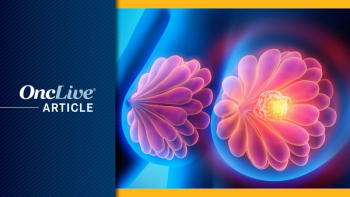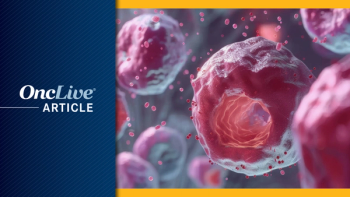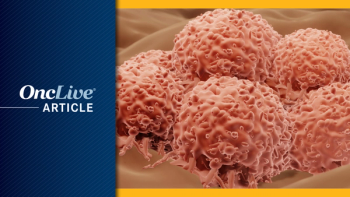
Dual Biomarker Signature Holds Predictive Promise for Response to Anti-PD-L1 Therapy in NSCLC
Recent research suggests that the presence of PD-L1–positive and CD8+ cells may be useful for predicting responses in patients with non-small cell lung cancer who have been treated with durvalumab.
Sonja Althammer, PhD
Recent research suggests that the presence of PD-L1—positive and CD8+ cells may be useful for predicting responses in patients with non-small cell lung cancer (NSCLC) who have been treated with durvalumab (MEDI4736).
Sonja Althammer, PhD, presented research on the association between improved survival rates to treatment with durvalumab and high CD8+ and PD-L1+ cell densities during a late-breaking abstract session at the Society for Immunotherapy of Cancer (SITC) 21st Annual Meeting & Associated Programs1.
Oncologists know that PD-L1 expression on tumor cells is correlated with improved responses to anti—PD-L1 treatment, said Althammer, leader of the Bioinformatics team at Definiens in Munich, Germany. However, the current study sought to discover whether the researchers could potentially improve the predictive value of PD-L1 by including inflammation from CD8.
They explored 12 similar approaches in a hypothesis-driven analysis to see how CD8 and PD-L1 cells could best predict patient responses to durvalumab treatment. Their goal was to improve patient selection for treatment with this anti—PD-L1 monoclonal antibody.
In findings from a phase I/II trial of durvalumab presented at the 2015 ASCO Annual Meeting,2 durvalumab showed a manageable safety profile in patients with NSCLC and durable responses, with 76% of patients (n = 149) still receiving treatment after 24 weeks. The objective response rate (ORR) for all evaluable patients was 14% and the ORR rate for patients with PD-L1+ expression was 23%.
To explore possible predictive biomarkers to the treatment, researchers examined biopsies from 163 patients with NSCLC to be treated with durvalumab. Each biopsy was tested for CD8 and PD-L1 cell densities through immunohistochemistry, and for combined expression using automated image analysis. Patients were considered to have high PD-L1 expression if there was ≥25% expression in the tumor cells at any intensity level. The amount of CD8 expression necessary was not expressed during the presentation.
Patients were divided into a discovery set (n = 84) and a validation set (n = 79) to confirm the hypothesis. The datasets were well balanced in terms of objective response rates, prevalence of PD-L1 status, lines of prior therapy, ECOG performance status scores, and response.
The determined cellular signature was based on the density of CD8 and PD-L1 cells in the tested tumor area. That density was determined with a ratio comparing the number of cells to the total analyzed tissue area.
“The beauty of this signature is that it is actually quite simple to calculate and you do not need any co-registration or alignment of the sections,” Althammer said.
Together, the CD8+ and PD-L1+ cell densities were associated with higher responses and improved survival rates. “For a response to durvalumab treatment, both cell populations actually need to be present,” Althammer stated.
In the discovery set, the ORR of patients with positive densities for both cell populations, which Althammer referred to as double-positive patients, was 42% (n = 26; 95% CI, 23-63), and in the validation set, the ORR of the double-positive subgroup (n = 33) was 36% (95% CI, 20-55). In both datasets, the ORR rate was greater for the double-positive subgroup than for patients with high CD8+ or PD-L1+ expression alone, and was significantly greater than the rate for patients with negative expression of either (TABLE).
For the combined datasets, the median overall survival (OS) for the 59 patients with CD8+ and PD-L1+ cell densities was 24.3 months (14.5—not evaluable) compared with 17.1 months (9.8-25.3) and 17.8 months (14.0–not evaluable) for patients with PD-L1+ expression alone and CD8+ expression alone, respectively. The median OS for all 163 patients in both sets was 11.1 months (7.9-15.0).
The OS for the double-positive subgroup was found to be clinically significant with a logrank P-value of .0005.
Median progression-free survival (PFS) for the combined groups was 7.3 months (4.0-7.9) for the double-positive subgroup, compared with 3.6 months (2.6-5.3) and 5.3 months (3.17.4) for patients with PD-L1+ expression alone and CD8+ expression alone, respectively. Overall median PFS was 2.8 months (1.7-3.8).
While the results did show an increased correlation to improved outcomes for patients with high CD8+ and PD-L1+ expression, this biomarker approach is still far off from being used in clinical practice.
“These are very encouraging results for us, however, we need to keep in mind that this is preliminary data and that it is important to confirm this analysis on an independent dataset,” Althammer said. In an interview, Althammer expressed that, with AstraZeneca, the manufacturer of the drug, researchers are looking to identify further trials for a confirmation study.
References
- Althammer S, Steele K, Rebelatto M, et al. Combinational CD8+ and PD-L1+ cell densities correlate with response and improved survival in non-small cell lung cancer (NSCLC) patients treated with durvalumab. Presented at: 2016 SITC Annual Meeting; November 9-13, 2016; National Harbor, MD. Abstract O1.
- Rizvi NA, Brahmer JR, Ou S-HI, et al. Safety and clinical activity of MEDI4736, an anti-programmed cell death-ligand 1 (PD-L1) antibody, in patients with non-small cell lung cancer (NSCLC). J Clin Oncol 33, 2015 (suppl; abstr 8032).

























































































